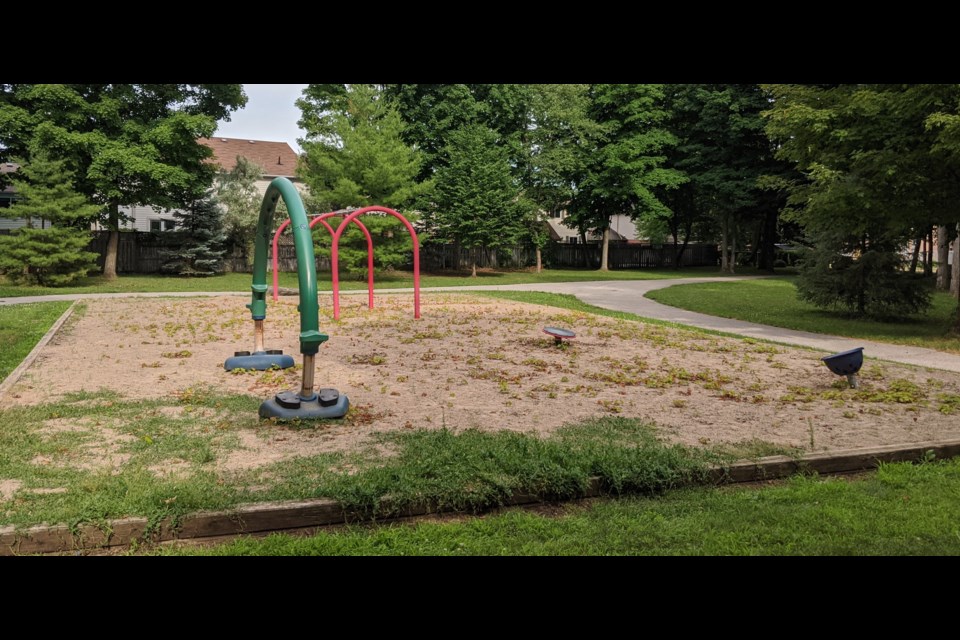Orillia might have to remove playgrounds from city parks if city council is unable to find alternative sources of cash to upgrade them.
The Accessibility for Ontarians with Disability Act (AODA) recently implemented changes that require all public playgrounds in Ontario to meet enhanced design standards by 2025. To meet those guidelines:
- Playground surfacing must be accessible (rubberized or engineered wood fibre);
- All playgrounds must have accessible connecting pathways which are wide enough to accommodate wheelchairs;
- Playgrounds must include handrails and ramps;
- Playground features should include adaptive swings, interactive games, elevated sandboxes, inclusive overhead climbers, shade and quiet areas etc.
“The enhanced standards will provide safe and accessible playgrounds but increased surfacing requirements and the additional pathways in particular mean the anticipated replacement costs have increased,” Ray Merkley, the city’s director of parks, recreation and culture told a budget committee meeting last week.
According to a report presented to budget committee, traditional playground units cost anywhere from $75,000 to $100,000. Similar-sized accessible playgrounds range from $100,000 to $250,000.
Merkley said the city’s larger playgrounds in community parks already meet the AODA standards.
“However there are several playgrounds that do not meet the standards and need to be upgraded by 2025,” he told council.
If they are not upgraded, council could opt to “decrease the level of service.” That would mean a “number of playgrounds would have to be removed.”
At that same budget committee (which includes the mayor and all city councillors), council directed staff to prepare a budget for 2021 that will end up with no tax increase. One of the ways that is to be accomplished is by not increasing the amount of money the city dedicates to its reserves.
Merkley went into the meeting hoping council would increase its annual contribution by $150,000 annually to the park equipment reserve. Last year, council increased its contribution by $50,000 to bring its annual investment to $136,000. The $150,000 request would more than double the annual contribution to $286,000.
The current balance of the reserve is $328,000.
“The current level of contribution to reserves is insufficient to allow the replacement and maintain the existing level of service,” said Merkley.
Increasing the contribution to reserves would allow the city, over the next four years, to upgrade all playgrounds to meet the AODA guidelines.
Coun. Ted Emond said it’s time the municipality begins to investigate new funding methods.
“There’s an assumption inherent in this report that the only way to finance this is through reserves and I’m not comfortable with that assumption,” said Emond.
“We could borrow money to finance this … there may be grants (available) from senior levels of government,” said Emond, adding staff should develop a financing plan for its projects.
Ultimately, the matter was referred to the 2021 budget deliberations in November.
JUST THE FACTS
The City currently owns and maintains 36 parks, which are classified into three different park types: Community Parks, Neighbourhood Parks, and Parkettes.
Community Parks are larger outdoor community gathering places where residents and visitors can enjoy celebrating Orillia’s natural beauty.
Neighbourhood Parks are the outdoor focal points of their immediate neighbourhood and are enjoyed mostly by residents who live nearby.
Parkettes are smaller spaces which offer limited amenities and provide small green spaces.
Within the 36 parks, 27 parks offer a playground for park users with one park, while Couchiching Beach Park, boasts two different play apparatus areas. The playgrounds vary in size and number of amenities based on the park classification.
Ontario municipalities typically replace playground equipment every 12 to 18 years. This replacement time frame varies on usage and durability (i.e. Couchiching Beach Park vs. Kaneff Park).
Some or all of the following parks would lose their play apparatus as of 2025 if the reserve is not fully funded in order to balance the reserve and to ensure sufficient future funding to replace larger play apparatus:- West Ridge Park
- Grenville Park
- Dancy Drive Park
- North Street Park
- Christine Place Park
- Forest Home Park
- Dorset Park
- Frontier Park
- High Street Park
- Kaneff Park
- Lawrence Park
- Mariposa Park
